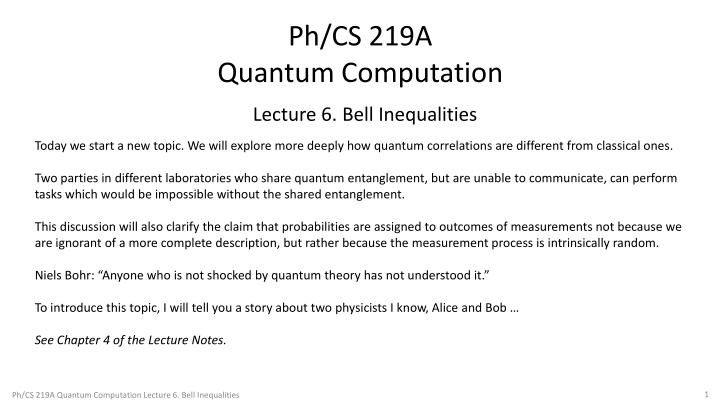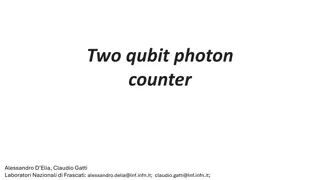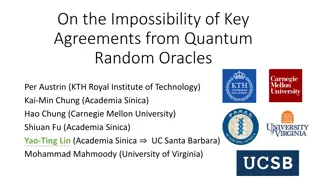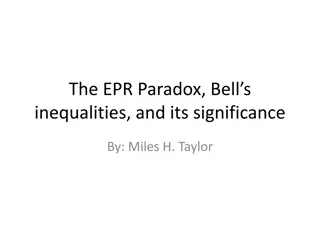Quantum Correlations and Bell Inequalities
Today's lecture delves into how quantum correlations differ from classical ones by investigating tasks achievable only through shared entanglement. The concept of intrinsic randomness in measurement processes will be highlighted through the narrative of physicists Alice and Bob.
Download Presentation

Please find below an Image/Link to download the presentation.
The content on the website is provided AS IS for your information and personal use only. It may not be sold, licensed, or shared on other websites without obtaining consent from the author.If you encounter any issues during the download, it is possible that the publisher has removed the file from their server.
You are allowed to download the files provided on this website for personal or commercial use, subject to the condition that they are used lawfully. All files are the property of their respective owners.
The content on the website is provided AS IS for your information and personal use only. It may not be sold, licensed, or shared on other websites without obtaining consent from the author.
E N D
Presentation Transcript
Ph/CS 219A Quantum Computation Lecture 6. Bell Inequalities Today we start a new topic. We will explore more deeply how quantum correlations are different from classical ones. Two parties in different laboratories who share quantum entanglement, but are unable to communicate, can perform tasks which would be impossible without the shared entanglement. This discussion will also clarify the claim that probabilities are assigned to outcomes of measurements not because we are ignorant of a more complete description, but rather because the measurement process is intrinsically random. Niels Bohr: Anyone who is not shocked by quantum theory has not understood it. To introduce this topic, I will tell you a story about two physicists I know, Alice and Bob See Chapter 4 of the Lecture Notes. 1 Ph/CS 219A Quantum Computation Lecture 6. Bell Inequalities
1 2 3 Three coins on the table. Each is either heads or tails. You can uncover any one of the three coins, revealing whether it is heads of tails, but when you two the other two coins disappear --- you ll never know whether those other two coins are heads or tails.
1 2 3 Three coins on the table. Each is either heads or tails. You can uncover any one of the three coins, revealing whether it is heads of tails, but when you two the other two coins disappear --- you ll never know whether those other two coins are heads or tails.
1 2 3 Three coins on the table. Each is either heads or tails. You can uncover any one of the three coins, revealing whether it is heads of tails, but when you two the other two coins disappear --- you ll never know whether those other two coins are heads or tails.
1 2 3 Three coins on the table. Each is either heads or tails. You can uncover any one of the three coins, revealing whether it is heads of tails, but when you two the other two coins disappear --- you ll never know whether those other two coins are heads or tails.
Donald (Denver) Bob Alice (Waterloo) (Pasadena) 1 2 3 1 2 3 There are many sets of coins, identically prepared by Donald. For each of the three coins, in Pasadena or Waterloo, the probability is that the coin is heads or tails.
Donald (Denver) Bob Alice (Waterloo) (Pasadena) 1 2 3 1 2 3 There are many sets of coins, identically prepared by Donald. For each of the three coins, in Pasadena or Waterloo, the probability is that the coin is heads or tails. But, if Alice and Bob both uncover the same coin, the outcomes are perfectly correlated.
Donald (Denver) Bob Alice (Waterloo) (Pasadena) 1 2 3 1 2 3 There are many sets of coins, identically prepared by Donald. For each of the three coins, in Pasadena or Waterloo, the probability is that the coin is heads or tails. But, if Alice and Bob both uncover the same coin, the outcomes are perfectly correlated.
Donald (Denver) Bob Alice (Waterloo) (Pasadena) 1 2 3 1 2 3 There are many sets of coins, identically prepared by Donald. For each of the three coins, in Pasadena or Waterloo, the probability is that the coin is heads or tails. But, if Alice and Bob both uncover the same coin, the outcomes are perfectly correlated.
Donald (Denver) Bob Alice (Waterloo) (Pasadena) 1 2 3 1 2 3 There are many sets of coins, identically prepared by Donald. For each of the three coins, in Pasadena or Waterloo, the probability is that the coin is heads or tails. But, if Alice and Bob both uncover the same coin, the outcomes are perfectly correlated.
Donald (Denver) Bob Alice (Waterloo) (Pasadena) 1 2 3 1 2 3 There are many sets of coins, identically prepared by Donald. For each of the three coins, in Pasadena or Waterloo, the probability is that the coin is heads or tails. But, if Alice and Bob both uncover the same coin, the outcomes are perfectly correlated. We know it always works we ve checked it a million times.
Donald (Denver) Bob Alice (Waterloo) (Pasadena) 1 2 3 1 2 3 There are many sets of coins, identically prepared by Donald. For each of the three coins, in Pasadena or Waterloo, the probability is that the coin is heads or tails. But, if Alice and Bob both uncover the same coin, the outcomes are perfectly correlated. We know it always works we ve checked it a million times.
Donald (Denver) Bob Alice (Waterloo) (Pasadena) 1 2 3 1 2 3 There are many sets of coins, identically prepared by Donald. For each of the three coins, in Pasadena or Waterloo, the probability is that the coin is heads or tails. But, if Alice and Bob both uncover the same coin, the outcomes are perfectly correlated. We know it always works we ve checked it a million times.
Donald (Denver) Bob Alice (Waterloo) (Pasadena) 1 2 3 1 2 3 There are many sets of coins, identically prepared by Donald. For each of the three coins, in Pasadena or Waterloo, the probability is that the coin is heads or tails. But, if Alice and Bob both uncover the same coin, the outcomes are perfectly correlated. We know it always works we ve checked it a million times.
Donald (Denver) Bob Alice (Waterloo) (Pasadena) 1 2 3 1 2 3 There are many sets of coins, identically prepared by Donald. For each of the three coins, in Pasadena or Waterloo, the probability is that the coin is heads or tails. But, if Alice and Bob both uncover the same coin, the outcomes are perfectly correlated. We know it always works we ve checked it a million times.
Donald (Denver) Bob Alice (Waterloo) (Pasadena) 1 2 3 1 2 3 Bob reasons: -- We know the correlation is always perfect, -- And surely what Alice does in Pasadena exerts no influence on what Bob finds when he uncovers a coin in Waterloo. -- So, in effect, Alice and Bob, working together, can learn the outcome when any two of the coins are uncovered in Waterloo.
Donald (Denver) Bob Alice (Waterloo) (Pasadena) 1 2 3 1 2 3 Bob reasons: -- We know the correlation is always perfect, -- And surely what Alice does in Pasadena exerts no influence on what Bob finds when he uncovers a coin in Waterloo. -- So, in effect, Alice and Bob, working together, can learn the outcome when any two of the coins are uncovered in Waterloo.
Donald (Denver) Bob Alice (Waterloo) (Pasadena) 1 2 3 1 2 3 Bob reasons: -- We know the correlation is always perfect, -- And surely what Alice does in Pasadena exerts no influence on what Bob finds when he uncovers a coin in Waterloo. -- So, in effect, Alice and Bob, working together, can learn the outcome when any two of the coins are uncovered in Waterloo.
Donald (Denver) Bob Alice (Waterloo) (Pasadena) 1 2 3 1 2 3 Bob reasons: -- We know the correlation is always perfect, -- And surely what Alice does in Pasadena exerts no influence on what Bob finds when he uncovers a coin in Waterloo. -- So, in effect, Alice and Bob, working together, can learn the outcome when any two of the coins are uncovered in Waterloo.
Bob Alice (Waterloo) (Pasadena) = ( , , ) 1 . P x y z Bell reasons: , , x y z { , } H T = = = + + + + + + + + + (1,2) (2,3) (1,3) ( ( ( ) ) ) ( ( ( ) ) ) ( ( ( ) ) ) ( ( ( ), ), ). same P P P P HHH P HHH P HHH P HHT P THH P HTH P TTH P HTT P THT P TTT P TTT P TTT same same + + (1,3) 1 2 ( = + ) 2 ( + ) 1 (1,2) (2,3) same P same P same P P HHH P TTT Why? Because if you uncover all three coins, at least two have to be the same!
Bob Alice + + (1,2) (2,3) (1,3) 1 same P same P same P (Waterloo) (Pasadena) Alice and Bob did the experiment a million times, and found (1,2) P 1 4 = = = (2,3) (1,3) same P same P same How could Bell s prediction be wrong? Bell assumed the probability distribution describes our ignorance about the actually state of the coins under the black covers, and that there is no action at a distance between Pasadena and Waterloo. The lesson: -- Don t reason about counterfactuals ( I found H when I uncovered 1; I would have found either H or T if I had uncovered 2 instead, I just don t know which. ) When the measurements are incompatible, then if we do measurement 1 we can t speak about what would have happened if we had done measurement 2 instead. -- Quantum randomness is not due to ignorance. Rather, it is intrinsic, occurring even when we have the most complete knowledge that Nature will allow. -- Note that the quantum correlations do not allow A and B to send signals to one another.
Bob (Waterloo) Alice + + (1,2) (2,3) (1,3) 1 same P same P same P (Pasadena) However, Alice and Bob did the experiment a million times, and found (1,2) P = 1 4 = = (2,3) (1,3) same P same P same Bell inequality violations are seen in experiments with qubits encoded in photons, atoms, electron spins, and superconducting circuits. There are loopholes : 1. Detection efficiency 2. Causality 3. Free will Bell inequality violation has been verified experimentally since the 1980s, but the first loophole free experiments were achieved in 2015. Alice and Bob shared a maximally entangled (Bell) pair of qubits, and each could perform a two-outcome measurement on her/his qubit in one of three possible ways. What did they measure?
Okay, whats really going on? 1 = | (|01 |10 ) Donald prepares a maximally entangled state of two qubits: 2 For Alice, the three coins that can be uncovered are three possible single-qubit observables that she may choose to measure, and same for Bob. These three operators are noncommuting, so measuring one disturbs a measurement of the others. That is why when Alice uncovers a coin (measures one of the observables), the other coins disappear (she can t know what would have happened if she had measured these observables instead). Heads and tails are two possible outcomes of measuring an observable which has eigenvalues +1 and -1. Because the state prepared by Donald is entangled, Alice s measurement outcomes are correlated with Bob s. The observables they measure have the form. a b for Alice, for Bob. ( ) + = 1 2 3 , , = | 0, I I i You can check: i i = = a a | | | ( )( ) | b I b b I b b I Therefore: = = a a a | | |( )( ) | tr( )( ) b b I A 1 2 1 2 1 2 where is the angle = = = = = a a b tr( )( ) tr( ) 2 cos b ab ab i j i j i j ij a b between and (repeated indices summed) 23 Ph/CS 219A Quantum Computation Lecture 6. Bell Inequalities
Okay, whats really going on? 1 = = = a a b | (|01 |10 ) | | cos b 2 )( a ) 1 = . b If measurement outcomes are the same, then ( )( a -1. b If measurement outcomes are different, then ( )= 11 cos 2 ( ) = = = = a | | c s o 2 1 b same P P sa e P same P diff m 1a When Alice and Bob uncoverthe same coin their measurement axes are anti-aligned. Then they always get the same measurement outcome. 3b 2b When Alice and Bob uncover different coins the angle between their measurement axes is 60 degrees. In that case they get the same measurement outcome with probability . 2 a 3a Bell was wrong, because he assumed incorrectly that he could assign probabilities of outcomes to measurements that were not performed. 1b The randomness of the outcomes is not due to ignorance --- it is intrinsic. 24 Ph/CS 219A Quantum Computation Lecture 6. Bell Inequalities
Clauser-Horne-Shimony-Holt (CHSH) Inequality a,a b,b correlated A B bits 1 1 Suppose the randomness of the outcomes is due to ignorance. If we had complete information we would know with certainty the values of: { 1}, 2 0 = { 1} , ' a = , a b b 2, 2. = = + = = ' a a a a a a + C C = + + a a b ( ') ( ') ' C a a b Consider: Notice that: ' a a = + + ' ' | 2 a b | | | | 2 | ' ' C C ab a b ab For a joint probability distribution governing these four binary variables: This is the CHSH Inequality. (Clauser was a Caltech physics BA, 1964.) 25 Ph/CS 219A Quantum Computation Lecture 6. Bell Inequalities
Clauser-Horne-Shimony-Holt (CHSH) Inequality a,a b,b correlated A B bits 1 1 a = + + ' ' | 2 a b | | | ' ' C ab a b b ab b ' b = = a a b | | cos 1 1 ' a = = | | 3 2 2 2. C 2 2 The CHSH inequality is violated. 26 Ph/CS 219A Quantum Computation Lecture 6. Bell Inequalities
Clauser-Horne-Shimony-Holt (CHSH) Inequality a = + + ' ' | 2 a b | | ' ' C ab a b b ab b ' b = = a a b | | cos 1 1 ' a = = | | 3 2 2 2. C 2 2 This the choice of binary observables that maximally violates the CHSH inequality. = = = = 2 2 2 2 , ', a a b e , ' b , ' b , , . a a I b a a b b O bs v e r a b l s o b e y com mut e w i t h + 2 a b a b = + + = + + + + ' ( + + 2 2 2 ( ) ( ) aa ( ' ) ' a a b b ') ( I ) ( ')( ') ')( ') ' a b b C = a a a a a + a a a a a bb a a a ' ( + = 4 ( ' a a ') ' 4 [ ', ][ a a , ] ' I aa bb b b = || || || || + || || + ||[ , ]|| 2|| A B || || || || max | | || ||, || || || || || A A A AB A B A B A B A B | ( ) 2 = || 4 4 + = = 2 2 || || || 8 2 2 | | 2 2 C C C C Hermitian (Cirel son Inequality) 27 Ph/CS 219A Quantum Computation Lecture 6. Bell Inequalities
Clauser-Horne-Shimony-Holt (CHSH) Inequality a = + + ' ' | 2 a b | | ' ' C ab a b b ab b ' b = = a a b | | cos 1 1 ' a = = | | 3 2 2 2. C 2 2 Bell inequality violations are seen in experiments with qubits encoded in photons, atoms, electron spins, and superconducting circuits. There are loopholes : 1. Detection efficiency. Alice and Bob don t have a fair sample because detection sometimes fails. 2. Causality. E.g., A measures first, and by the time B measures, a signal could have traveled A B. 3. Free will . Hidden variables govern not only the outcomes, but also what A and B choose to measure. Bell inequality violation has been verified experimentally since the 1980s, but the first loophole free experiments were achieved in 2015. These simultaneously close the detection and causality loopholes. Bell inequality violations have been seen in experiments where A and B measurement choices of what to measure are governed by brightness fluctuations in stars hundreds of light years apart. 28 Ph/CS 219A Quantum Computation Lecture 6. Bell Inequalities
CHSH Game a b , , , ( 1) ,( 1) {0,1} a b x y { 1}. x y correlated = = 0 1 x x a a is Alice s output if her input is , 0 A B is Alice s output if her input is . 1 bits ( , ) ( 1) ( 1) , p a b a b is probability of winning for inputs ( ) = = x y (0,0) 1 (0,0) 2 (0,0) 1. p p p 0 0 x y Similarly, = x y a b = = x y ( 1) ( 1) ( 1) ( 1) ( 1) ( 1) 2 (0,1) 1, 2 (1,0) 1, 2 (1,1) 1. p = p 0 1 Goal: y x p 0 1 + x y 1 1 1 4 ( ) ( ) + + + + + + 2 (0,0) (0,1) (1,0) (1,1) 4 2 (0,0) (0,1) (1,0) (1,1) 3/ 4 p p p p p p p p CHSH inequality: Averaged uniformly over inputs, no classical strategy can win the game with success probability better than .75 For quantum strategies , the highest possible success probability improves to ( ) ( 2 (0,0) (0,1) (1,0) (1,1) 4 2 2 4 ( ) 1 1 8 1 2 1 ) + + + + + + 4 2 2 + = + = (0,0) (0,1) (1,0) (1,1) .853 p p p p p p p p 2 2 29 Ph/CS 219A Quantum Computation Lecture 6. Bell Inequalities
a b Bell inequalities more generally Now a, b are possible measurement settings for Alice and Bob, taking m possible values. correlated A B bits And x, y are possible measurement outcomes taking v possible values. x y ( | ) p xy ab denotes the conditional probability of outcomes when settings are We call a "state" and denote the space of possible states by , , . a b x y ( | ) p xy ab ( | ) p xy ab . ) 1 = 1 : ( | , . a b p xy ab F or any choice of set in s t e pro ab lities of outc t g , h b i o e sum m s t o f o r l a l , x y = = = = 2 2 | | ( 1). | | 12 2. m v m v Therefore , the state sp ace has d i m e n s i o n For example , for In a local configuration there is a definite x for each a (which does not depend on b), and a definite y for each b (which does not depend on a). A local model also known as a local hidden variable theory (LHVT) assigns a probability to each local configuration. Bell inequalities are constraints on p(xy|ab) that apply to any local model. 30 Ph/CS 219A Quantum Computation Lecture 6. Bell Inequalities






